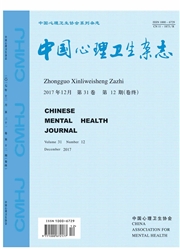

 中文摘要:
中文摘要:
目的:考察简化情绪量表中文版的信度和效度。方法:采用分层抽样,从4所中学选取1728名中学生,进行简化情绪量表的信度和效度分析。以长处和困难问卷与儿童焦虑性情绪障碍筛查表为效标关联效度,随机抽取30名中学生间隔4周重测,评定重测信度。结果:简化情绪量表中文版的Cronbaeh α系数为0.89,P〈0.01,重测相关系数为0.84,P〈0.01。简化情绪量表中文版与长处和困难问卷的情绪症状因子相关(r=0.67,P〈0.01),与儿童焦虑性情绪障碍筛查表的躯体化/惊恐、广泛性焦虑、分离性焦虑、社交恐怖、学校恐怖因子及总分的相关系数分别为0.69、0.77、0.57、0.44、0.57、0.75,均P〈0.01。探索性因素分析各条目的因素负荷在0.54—0.73之间,主成分分析共抽取2个因子,解释变异量的50.6%。验证性因素分析的拟合指标X^2/df、RMSEA、GFI、AGFI、NNFI、CFI分别为7.28、0.06、0.96、0.94、0.97、0.98。结论:简化情绪量表中文版的信度、效度均较理想,符合心理计量学要求。
 英文摘要:
英文摘要:
Objective: To evaluate the reliability and validity of the Chinese version of the Short Mood and Feelings Questionnaire (SMFQ) . Methods: Using stratified cluster sampling, a total of 1728 students from four middle schools were tested. The split-half reliability , test-retest reliability , internal consistency reliability were reexamined. A factor analysis procedure was used to explore the factor structure of SMFQ. The criterion-related validity was evaluated through correlating SMFQ with Strength and Difficulties Questionnaire ( SDQ ) and Screen for Child Anxiety Related Emotional Disorders [SCARED) . Thirty students completed SMFQ retest 4 weeks later. Results: The Cronbach's α coefficient was 0. 89 ( P 〈 0. 01 ) ; the test-retest reliability was 0. 84 ( P 〈 0. 01 ) . Significant correlations were found between SMFQ and SDQ subseales of emotional symptoms ( r = 0. 67 ) and SCARED ( r = 0.75 ) . Exploratory factor analysis extracted 2 components, and the percentage of variance explained was 50. 6%. Confirmatory Factor Analysis showed that the fit indexes for X^2/df, RMSEA, GFI, AGFI, NNFI, CFI were 7.28, 0. 06, 0.96, 0. 94, 0. 97 and 0. 98 respectively. Conclusion: The SFMQ have good psychometrics properties, with adequate reliability and validity, and canbe is applicable to assess the mood of Chinese adolescents.
 同期刊论文项目
同期刊论文项目
 同项目期刊论文
同项目期刊论文
 期刊信息
期刊信息
